Nikon 17-55mm f/2.8G ED-IF AF-S DX Nikkor Lens Review
Nikon 17-55mm f/2.8G ED-IF AF-S DX Nikkor Performance
At 17mm, sharpness levels in the centre of the frame are already excellent at f/2.8, although sharpness towards the edges of the frame is only fairly good. Stopping down improves sharpness across the frame and peak clarity is achieved between f/5.6 and f/8, where sharpness in the centre is outstanding, and excellent towards the edges of the frame.At 28mm, some of the sharpness from the centre seems to be have traded for increased clarity towards the edges of the frame. Now, at f/2.8 sharpness in the centre remains excellent, but the quality towards the edges has increased to good levels. Just the same as at 17mm, peak clarity across the frame is achieved between f/5.6 and f/8 for this focal length.
Finally, at 55mm, sharpness in the centre has dropped off a little, but remains very good, and the quality towards the edges of the frame has dropped down to fairly good levels. Peak quality across the frame is realised at f/5.6 for this focal length.
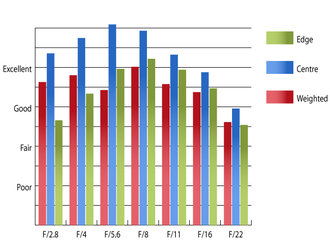 Resolution at 17mm | 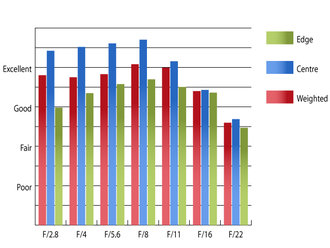 Resolution at 28mm | |
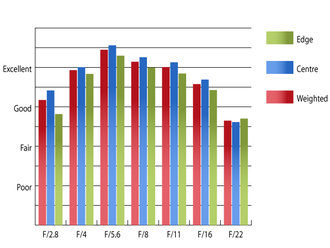 Resolution at 55mm | How to read our chartsThe blue column represents readings from the centre of the picture frame at the various apertures and the green is from the edges. Averaging them out gives the red weighted column.The scale on the left side is an indication of actual image resolution. The taller the column, the better the lens performance. Simple. For this review, the lens was tested on a Nikon D300 using Imatest. |
Chromatic aberrations are quite prevalent throughout the zoom range across all of the frame. At their worst fringing exceeds 1.5 pixels widths towards the edges of the frame with the lens stopped down beyond f/16. This level of fringing may become apparent in large prints, especially those with high contrast towards the edges of the frame.
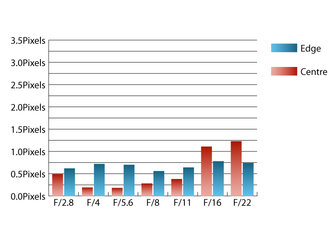 Chromatic aberration at 17mm | 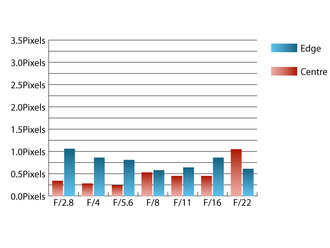 Chromatic aberration at 28mm | |
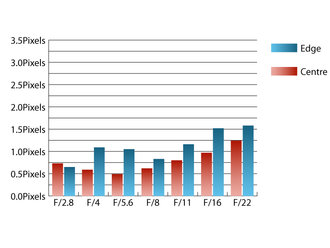 Chromatic aberration at 55mm | How to read our chartsChromatic aberration is the lens' inability to focus on the sensor or film all colours of visible light at the same point. Severe chromatic aberration gives a noticeable fringing or a halo effect around sharp edges within the picture. It can be cured in software.Apochromatic lenses have special lens elements (aspheric, extra-low dispersion etc) to minimize the problem, hence they usually cost more. For this review, the lens was tested on a Nikon D300 using Imatest. |
Falloff of illumination towards the corners of the frame is reasonably well controlled for a wide aperture zoom. At 17mm the corners of the frame are 1.39 stops darker than the image centre, and at 55mm, the corners are 1.08 stops darker. Visually uniform illumination is achieved at f/5.6 throughout the zoom range.
Distortion at either end of the zoom is a little on the strong side too. At 17mm 3.56% barrel distortion is present and at 55mm this is replaced with 1.21% pincushion distortion. Luckily the distortion pattern is uniform across the frame at either end of the zoom range, which should make applying corrections in image editing software relatively easy to apply.
A deep petal shaped hood that encloses the front element as it extends during zooming is supplied, which does an excellent job of shielding the front element from extraneous light that may cause issues with flare. Even without the hood, flare is rarely much of an issue. Shooting with the sun in the frame can occasionally cause issues, but contrast holds up well, even when shooting into the light.
Add your message
Login required
Please login here or if you've not registered, you can register here. Registering is safe, quick and free.
Please login here or if you've not registered, you can register here. Registering is safe, quick and free.
photodo Stats
1102 lenses
428 MTF tests
74 in-depth photodo reviews
100+ users join each day
Help the lens community by reviewing or rating a lens today via our lens search
428 MTF tests
74 in-depth photodo reviews
100+ users join each day
Help the lens community by reviewing or rating a lens today via our lens search
Latest Lens Reviews
- Chinon 28mm f/2.8 Vintage Lens Review
- Canon EF 70-200mm f/4L IS II USM Lens Review
- Samyang AF 85mm f/1.4 EF Review
- Sigma 70mm f/2.8 DG Macro Art Review
- Samyang AF 24mm f/2.8 FE Review
- Meike 50mm f/1.7 Review
- Tamron 70-210mm f/4 Di VC USD Review
- Lensbaby Burnside 35mm f/2.8 Review
- Asahi Super Takumar 50mm f/1.4 Review
- Asahi Super-Multi-Coated Takumar 135mm f/3.5 Review
